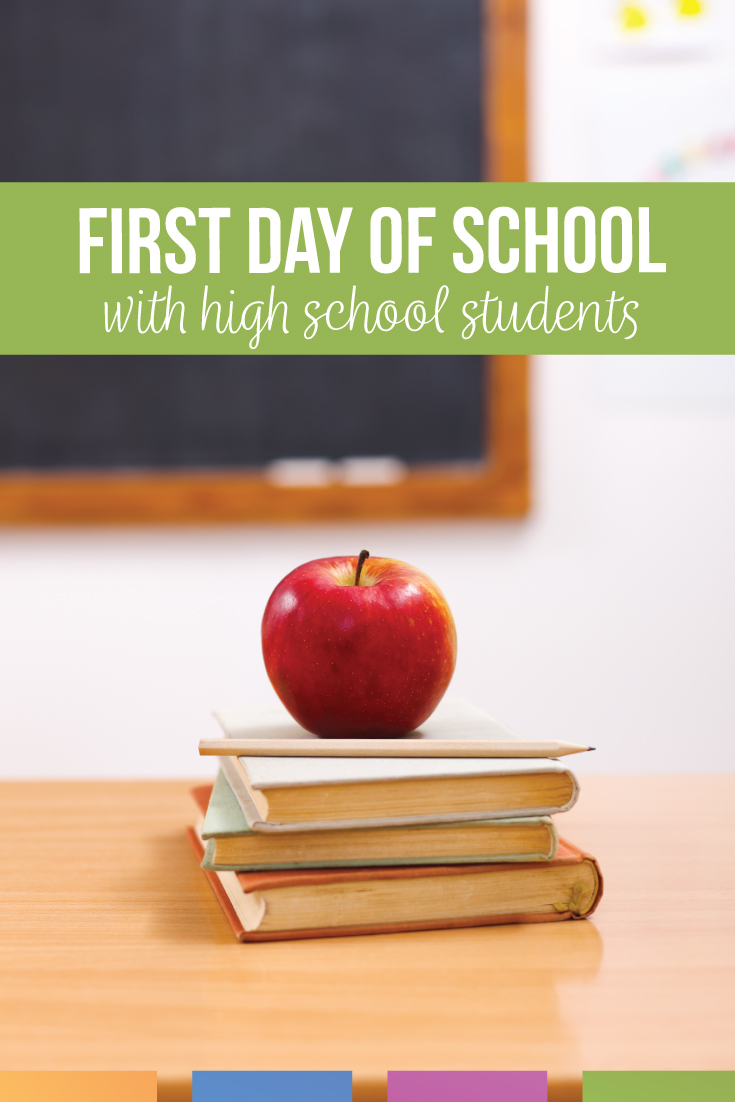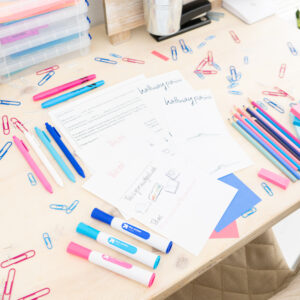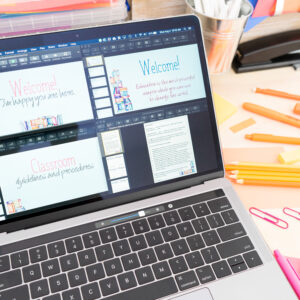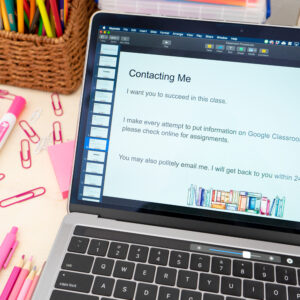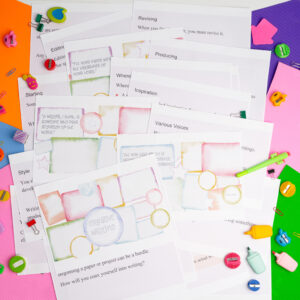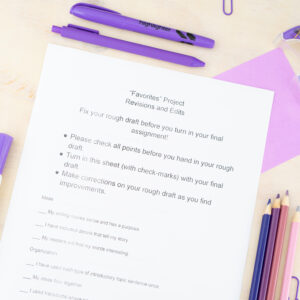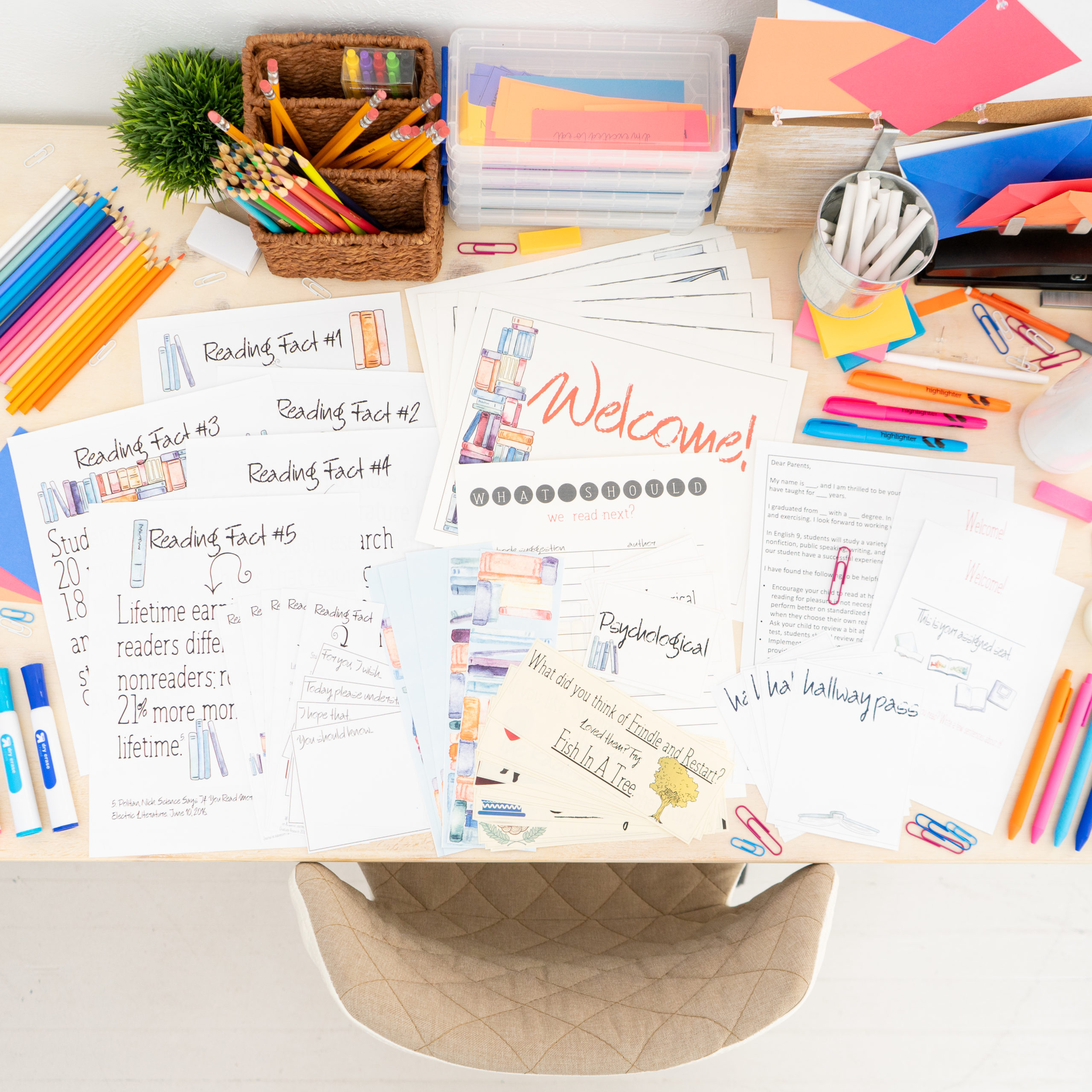That first day of school with high school students, lots can be determined. Students will meet you for the first time, see your room for the first time, gauge the class for the first time.
I’m not trying to overdramatize the situation or scare new teachers.
It’s true though: The first day matters. It’s why professionals can’t sleep the night before their 33rd year of teaching.
How can you plan a positive first day of teaching high school English?
The first days of school should be calm, organized, and positive. Here are a few points that I (and admittedly—I have a type-A personality) do every year, before that first day of teaching a new year.
Start the relationship process.
Educators talk lots about building relationships with students, and yes, that is important. I would argue that building a classroom community of learners with a focus on literacy is actually the start to building relationships.
Think about the relationships you want with students in November or December. For me, I want students to share news about their clubs, organizations, and sports. Hopefully, they give me insight into what they are reading. If they are struggling in some way, either at home or at school, I want them to know I’ll help.
How do we get there? For me, the first day of school is the time to build respectful and education-oriented relationships.
Syllabus? Icebreaker?
The Internet would have you believe that two types of teachers exist: Ones who start the school year with an exciting activity like a scavenger hunt or an icebreaker, and ones who start by reading the syllabus.
This positioning is a false narrative, a false dichotomy really. On your first day of teaching, you have plenty of ways to greet your new class. Building a cohesive community and establishing strong classroom management is possible without one extreme or the other.
My classes learn about the course, the expectations, and routines. I explicitly explain what they will do every day. In many cases, for example, students start with a “do-now”—a bellringer of sorts. By explaining, students have fewer questions and less stress.
Organizational tools.
The first day of class, students arrive with a name card on their assigned seat. I assign seats for several reasons.
One, new students (to the school district) have a spot to go. They are not looking around, unsure of where to sit.
Two, some IEPs and 504 plans require that students be by the teacher, by the door, near a speaker, or other requirements. Assigning seats allows me to follow those legal documents without announcing to the rest of the class those accommodations.
Three, I can learn names. Especially with a large class, organized rows and seats help me to learn names—an important part of building relationships.
Finally, the initial seating chart is not the final one! As we grow as a class, work in groups, and discuss topics, our seating chart will change. Normally, about the fourth week of school or so, classes ask me if they can move around. The answer is normally YES.
Routines and procedures.
On your first day of teaching, you will have jitters. Guess who else will too? Your students! You can be the focused and calm teacher to help students.
A great way to calm yourself and your new classes is by outlining expectations in a calm and smooth manner. Once classes are seated, explain that you need to take attendance. My first time through a roster is lots of stumbling! Assure students you want:
• To get names, nicknames, pronouns, and pronunciations correct. Spending time doing so is the start of a respectful community.
• To take accurate attendance. If a student is in the wrong room, for instance, direct them to the right space.
• To have everything in order. After taking attendance, I encourage students to send me an email or stay after class if there was something they wanted to share that they did not want to share in front of everyone.
My first year of teaching, I read the syllabus to my classes, and they looked over it while I took attendance. Now, students have their first activity for me.
Taking attendance and having students work is your first step in building an organized learning community. Every day, follow the same routine and on the first day of school, I explain that is our goal every day: Students begin working while I take attendance.
Ta-da! We feel success on that first day.
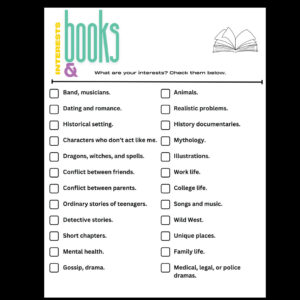
Readers.
A large goal of mine is for students to see themselves as readers and life-long learners. My survey of student interests allows teachers to see what interests each individual. Then, I sorted out over fifty book suggestions to align with the interests. The interests include ideas like family, work, band, animals, mythology, mysteries, and so on.
From the beginning, establish with classes that you will be reading, that you value what they enjoy about reading, and that you are willing to help them find a suitable book.
And? This little tool goes a long way to establish relationships.
First assignments: quizzes? pre-assessments?
The goals of my first assignments including getting to know students, seeing where my classes are regarding curriculum, and building rapport. When I give a pre-assessment, I stress to students that these are not for the grade book. Instead, I explain that I don’t want students to be confused and that I do not want to bore them. Understanding their knowledge helps me to help them.
Honestly, explaining this process to students might seem unnecessary, but I promise it isn’t. Walking classes through the purpose behind an assignment leads to discussions about metacognition.
Literature.
When I taught freshmen, I learned that my feeder schools (the middle schools) taught a variety of literary devices with different definitions. To get common domain-specific vocabulary, I check students’ understanding of common literary terms.
Grammar.
Language standards are tough, and some review might be necessary. For instance, eighth graders learn about active and passive voice. To understand verb voice, students must be able to identify subjects and verbs. A pre-assessment shows what concepts you need to cover before you teach new concepts.
Writing.
On the first day of school, my students write about their reading material and habits. Not only do I read their responses to learn about them, but I also evaluate their writing. (Is there anything I should address immediately, perhaps confusing words or incomplete sentences?) Then, we work from that point.
Of course, you might have your own pre-assessments; these are merely mine. Keep the scores and as the school year progresses, show students how they have grown. When you invest in students and spend time explaining about their growth, your classroom succeeds and again, you are leading to conversations about metacognition.
Community building activities.
As we continue the first week of school, we work on activities that prove to students we can and will learn together. From simple reviews on anchor charts to more elaborate activities reviewing the writing process, here are some of my first class activities:
Creative writing.
Teaching a creative writing course or starting the year with a creative writing assignment? Get students into groups and have them discover creativity in their own lives. From the color at a restaurant to the designs on a billboard, creativity is everywhere. Use a graphic organizer to spur ideas.
Then, you will have established your belief that all students are creative and capable, and you will also have tools to reflect back on.
Writing process.
This activity works best for seventh through tenth grades, and it is one of my favorites. Walk through the writing process with the topic of cookies. A brief outline of our activities:
Brainstorm/Pre-write: What are cookies? What are your favorite types of cookies? When do we eat cookies? What about the history of cookies? What ingredients commonly make cookies?
Draft: Narrow down topics! Show students how smart they are with great ideas, but for one paper, we must narrow down the topic of cookies. (After all, people write entire books about cookies.) Begin drafting together (share the presentation in that download with the class), and be sure to use domain-specific language for modeling.
Revision: Let’s take a look at flow, organizational patterns, the thesis, and all topic sentences. Since the presentation is shared, teachers can comment in real time.
Edits: Time to work on errors and to make improvements. (Again, identify if you have common areas to address.)
Publication: I copy and paste the class’ shared presentation into a document (normally on Canva). For the publication day, I also splurge and bring in cookies for the class to share.
Then, for the rest of the school year as we walk through the writing process, collectively, we can say, “Remember, you can’t write about ingredients for making cookies AND putting icing on cookies at your grandma’s house. One is an informative paper, and the other is narrative.” You’ll have a common activity that everyone in the group enjoyed to emphasize the writing process.
Narrative writing.
When I taught middle school, students and I walked through the writing process by sharing their “favorites” with their classmates and me—favorite foods, movies, books, sport, anything! Since “what you did over summer break” can be heartbreaking to some students, this alternative allows classes to share within their comfort zones.
The first day of teaching is merely one day, and yes, you should plan for it.
Equally as important, you must prepare your first activities which might start your second day. As you dive into your curriculum, teach lessons that allow you to sculpt the classroom environment that will keep everyone learning all year.
Overall:
For my first day of teaching a new school year, simplicity is key. Here is a quick rundown of my “dos” and “don’ts.”
I do. . .
- Double check the syllabus, before printing or uploading. Do not print or upload it at night! Read over it in the morning. This will likely be the first thing your students receive from you. Don’t let it have any errors.
- Know what you are presenting. The first day, I quell fears by showing students where they should go and what they can expect. I give a brief presentation because students are nervous, they have questions, and I want to put students at ease.
- Keep extra copies of whatever you will be giving students. Students switch in and out of classes, and you don’t want to make a printer run. Be sure that if you are uploading the material to a Google Classroom (or a similar platform), you have it in an easy spot.
- Make notes. The days leading up to that first day, walk around with a small notebook if needed. Write down ideas that you want to cover with students. You could include points that you want to show students (they may borrow your books, only sharpen a pencil when you are not speaking).
- Write out talking points. Take the ideas from above and common sense topics for the first day. Create a polished list you can take to the front of the classroom.
- Have everything organized. I’m sure you are pumped to decorate a classroom for the first time, but as a reminder: have the classroom ready. Show students that this is a learning environment, and you are prepared. I do NOT suggest spending a ton of money. A tidy classroom is more effective than a loud one that overwhelms the senses.
- Decide what you are wearing the night before. Don’t rush that morning: be ready. Have your clothes and bag ready. Try to sleep.
I could write on and on about first day tips, but those are the ones that after decades of teaching that I still follow.
We establish expectations for learning. My message during the first day of teaching is that we will learn together and that I am passionate about my content, ready to lead them.
I don’t. . .
What don’t I do for the first day of teaching?
I do not worry about ice breakers for high school students or put them on the spot. Some teachers are high energy—and that is fine! In my experience, that momentum is impermanent. Performing every day at high energy does not work for me or my classes day in and day out. That first day of teaching, I am warm and organized. However, being my natural self builds far more relationships with student than a fake performance that feels unnatural to me.
Therefore, I am very calm the first few days of school. We discuss literacy and its importance, expectations and procedures, and class basics.
Then, after students’ nerves are calmed, we work in groups, at stations, and with interactive tools. We do have fun, and that is because in the beginning, we established safety, camaraderie, and expectations.
And? Teachers are helpful. You can reach out on social media and hopefully within your school for more advice for that first day of teaching high school students.
For your first day of teaching, you should expect to be nervous. Prepare to be prepared. Expect to be tired, and elated, and proud.


